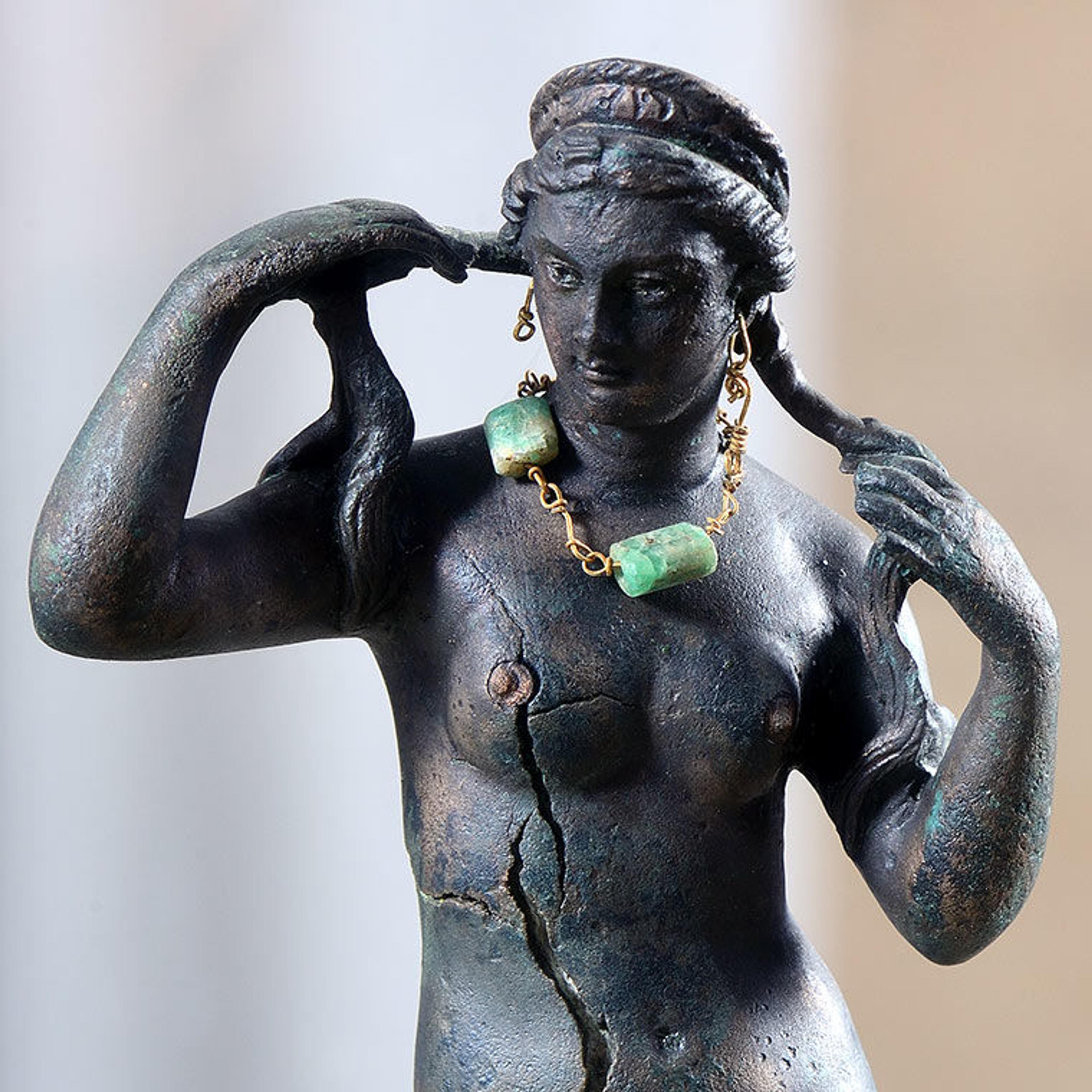
Detail of statuette of Aphrodite Anadyomene, ca. 1st–2nd century. Lebanon, Baalbek. Bronze, gold, semi-precious gems, H. 5 7/8 x W. 2 5/8 x D. 1 in. (14.8 x 6.5 x 2.4 cm). National Museum, Beirut
When Anne-Marie Maïla-Afeiche, the director of the National Museum in Beirut, Lebanon, visited the Departments of Objects Conservation and Scientific Research at The Met last spring, she expressed concern about the condition of one of the Lebanese objects that would be coming to New York for the exhibition The World between Empires: Art and Identity in the Ancient Middle East. Although overshadowed by nearby monumental stone sculpture, the small bronze statuette of Aphrodite Anadyomene ("Aphrodite rising from the sea") is one of the most superbly crafted objects in the show and worthy of close inspection.
Discovered at the site of Baalbek in the Beqaa Valley, the figure shows the goddess of love and sensuality, her arms raised, holding her long locks of hair. Ms. Maïla-Afeiche had questions about the conspicuously large cracks found on both sides of the torso. She wanted to know what had caused them, and whether they could grow and lead to serious damage in the future. She also wondered if the other materials found on this figure could be identified using instrumental analysis.
Front and back of statuette of Aphrodite Anadyomene, ca. 1st–2nd century. Lebanon, Baalbek. Bronze, gold, semi-precious gems, H. 5 7/8 x W. 2 5/8 x D. 1 in. (14.8 x 6.5 x 2.4 cm). National Museum, Beirut
The Met is fortunate in having considerable technical resources at its disposal to determine how art objects are made, how they may have changed over time, and what steps need to be taken to preserve them. Conservators and conservation scientists work side by side, their complementary training and expertise ensuring that the most relevant questions are identified and investigated appropriately. In this case, we agreed that the questions posed by this figure could be answered by radiography, along with surface analyses using X-ray fluorescence spectroscopy (XRF) and Raman spectroscopy (Raman), without the need to take any samples.
There was only a short window of time between the statuette's arrival at the Museum and its installation in the exhibition. With the permission of Dr. Sarkis El-Khoury, Director General of Antiquities of Lebanon, the small figure of Aphrodite arrived and was brought to our labs. The examination was overseen by the National Museum's courier, Nathalie Alam.
Left: Digital radiograph of Aphrodite Anadyomene. Right: Courier Nathalie Alam looks on as conservator and co-author Jean-François de Lapérouse prepares to radiograph the figurine
Radiography revealed that while the head, arms, and lower legs of the Aphrodite figure are solid, the torso appears hollow, with thin walls around a central core. This finding is consistent with a process of direct lost-wax casting over a ceramic core. In this process, a figure to be cast is modeled in wax over a clay form. After the modeling is complete, the wax is covered with an investment of clay. The clay investment hardens into a ceramic mold when it is fired, as does the ceramic core, and the wax in between flows out. Molten metal is then poured in, filling the space formerly occupied by the wax. (For a more detailed description of the direct and indirect lost-wax casting process, see this essay on the Heilbrunn Timeline of Art History.)
Although small statuettes such as the Aphrodite could be cast solid, a ceramic core offered advantages. Such a core reduced the amount of metal needed. It ensured that the mold filled quickly before the molten metal began to cool and solidify, and it could also absorb some of the gases that evolved in casting, which could otherwise block access to parts of the mold. In the case of Aphrodite Anadyomene, this method would have been useful to ensure that her long, thin locks received enough metal.
But the fact that the core appears as a bright white area in the radiograph is surprising. One would expect solid metal to be lighter in radiographs than ceramics; ceramics are less dense to X-rays, so areas with a ceramic core usually appear darker in radiographs. What is the material of the core?
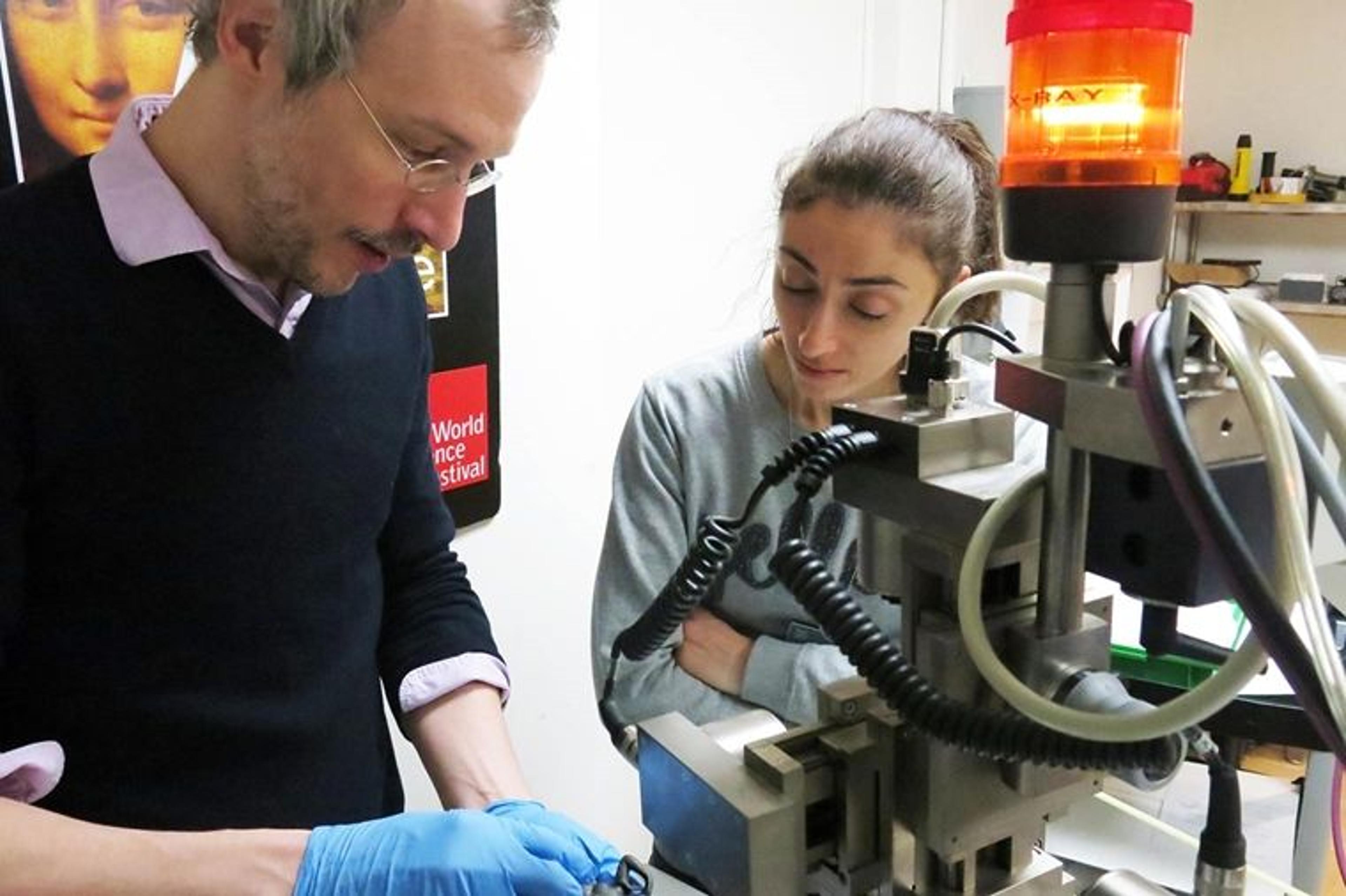
Research scientist and co-author Federico Carò preparing for XRF analysis with Nathalie Alam looking on
Before producing the digital radiograph, we conducted surface analyses at a few spots, using XRF, to determine what material the figure was made from. These analyses yielded a fairly consistent composition with an average of 81% copper, 15% tin, and 4% lead by weight. During the Roman period, when this figure was made, lead was often added to copper-tin alloys (i.e., bronze) to lower the melting point and assist the flow of metal in the mold.
But when we reexamined the surface of the figure to see if it offered any clues to the unusual core seen in the radiograph, our attention was drawn to an area on the back of the proper left shoulder, defined by a circular crack, that had a slightly different patina. XRF analysis showed that this spot contained approximately 9% more lead than the rest of the figure. Ancient artisans were adept at taking advantage of variations in the melting point of metal alloys when repairing flaws in cast objects, so it is likely that this area was deliberately given a lower melting point than the rest of the figure.
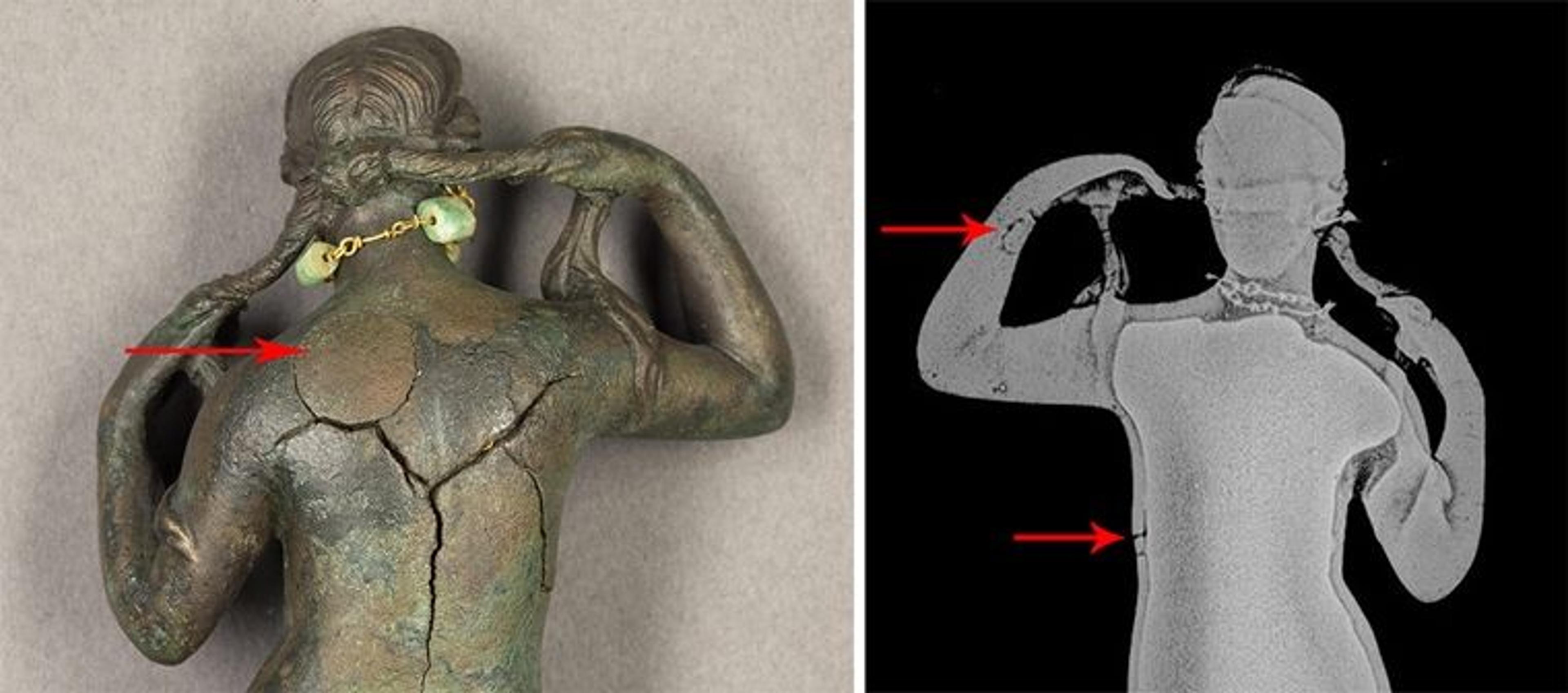
Left: Detail of circular patch on the back of the Aphrodite figure. Right: Radiograph edited with an edge filter to bring out casting details, including flaw porosity, as indicated by arrows
Considering all the evidence, we suspect that the casting flaw in the shoulder, where the metal is different, marks a hole through which the original ceramic core was removed in ancient times (above left). After the ceramic core was removed, the interior space was then filled with an alloy that was more radio-opaque than the metal used to cast the figure itself. This alloy may have contained a significant amount of lead, which lowered its melting point enough that the statuette was not distorted when the molten metal was poured in. Further XRF analysis, planned after the exhibition closes and before the figure is returned to Beirut, may provide some information regarding the composition of the core.
We can only guess at why the original ceramic core was replaced with metal. Porosity found elsewhere on the radiograph, particularly in the statuette's right arm and side (above right), indicates that the casting was not perfect. Perhaps some cracks were already visible on the surface and/or it was feared that the walls of the torso were too thin and needed the support that a metal would provide. The provision of a metal core was an ingenious solution that may have worked well until the statue ended up in the ground and began to undergo oxidation. Metals expand as they corrode, and it is possible that the core expanded more than the statue itself, causing the cracks to open up and/or expand.
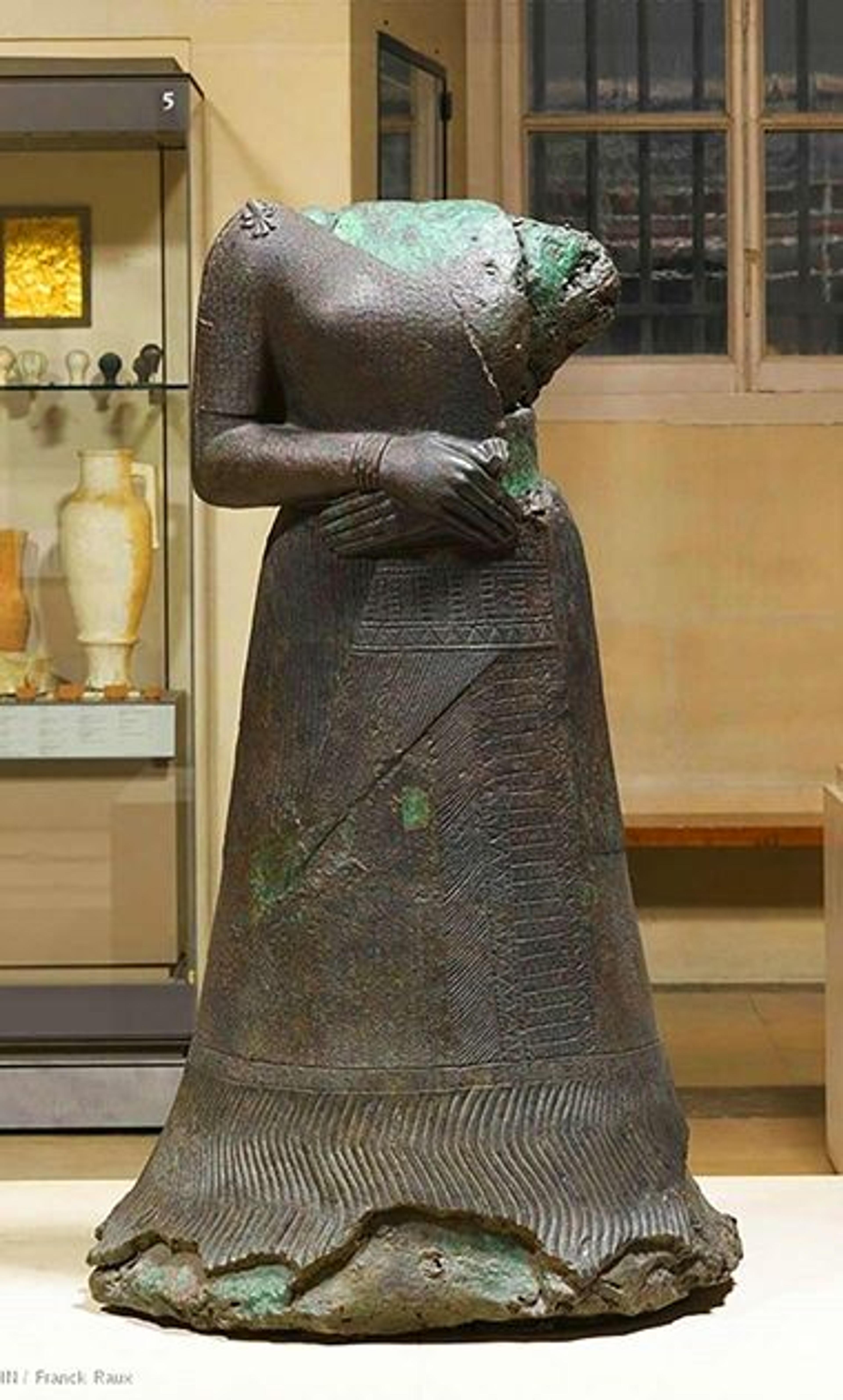
Right: Statue of Queen Napirasu. Musée du Louvre © 2010 RMN/Franck Raux
We know of one similar case from the ancient world. The ceramic core in the Middle Elamite statue of Queen Napirasu (14th century BCE) (left), now in the Musée du Louvre, was also replaced with an alloy whose melting point was lowered by an excess of tin. This may have been done to make this life-sized statue so heavy that it could not be stolen from its intended location. But it's also possible that there were flaws in the cast that needed reinforcement, as in the case of Aphrodite Anadyomene. We are now on the lookout for additional instances in which cores were replaced with metal.
Having identified the method of construction, the material, and the probable cause of the cracks, we had two more questions to answer.
Ms. Maïla-Afeiche wondered whether the cracks on the museum's Aphrodite might get worse over time. The fortunate news is that they should not increase or enlarge, as long as the figure is not exposed to high moisture levels. The statuette should also not be exposed to materials containing volatile compounds that promote metal corrosion. Today, museums and manufacturers re-examine and test the components used in enclosed storage areas and exhibition cases to ensure that they do not contain such materials.
Detail of Aphrodite showing inlaid eyes and nipples, as well as emerald beads
Finally, she asked about the other materials found on the figure. Additional XRF analyses indicate that Aphrodite's nipples are inlaid with relatively pure copper, while the eyes are inlaid with silver. Colored stone or glass, now missing, was most likely inlaid to render the iris and pupils. The beads strung on the gold wire necklace were identified by a combination of XRF and Raman as the chrome-containing, green variety of beryl known as emerald.
The visual contrast between these materials—bronze, copper, silver, gold, green emeralds, and stone or glass—must have been even more evident when the statue was first made, adding to the luxurious character and dazzling radiance of this divine figure.
The World between Empires: Art and Identity in the Ancient Middle East is on view at the Met Fifth Avenue through June 23, 2019.
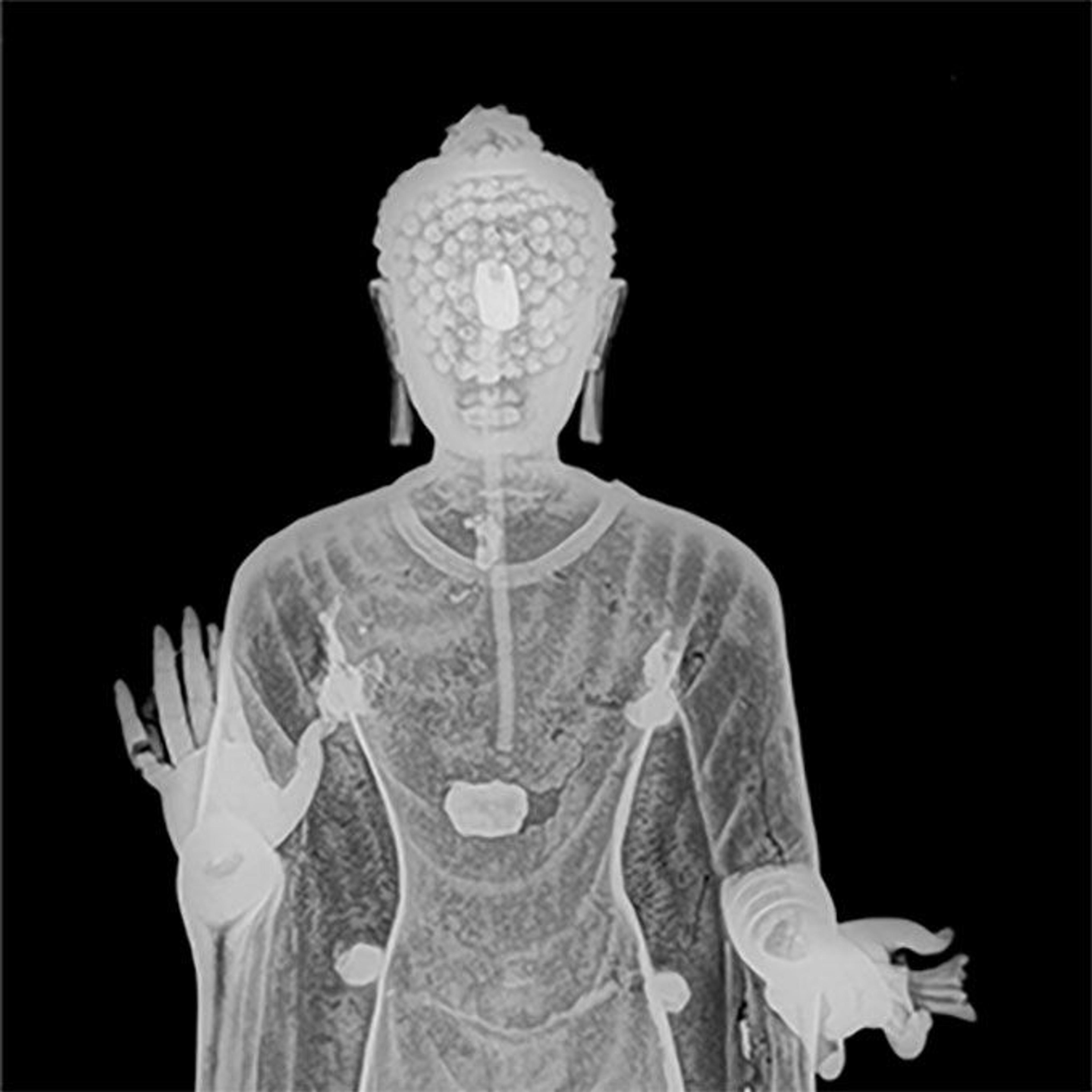
Enlightened Technology
Researchers at The Met used 3-D X-ray technology to explore the inside of a bronze statue of the Buddha. Here's what they found.
